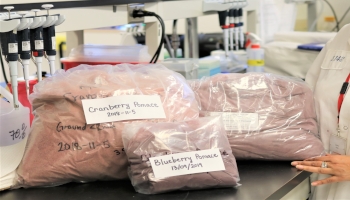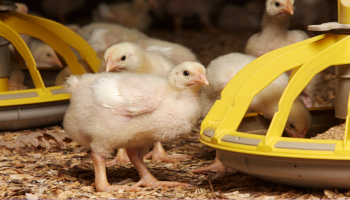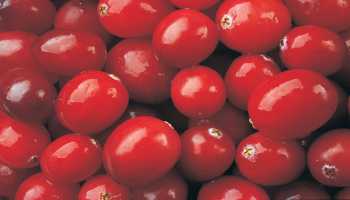For more information
Media Relations
Agriculture and Agri-Food Canada
1-866-345-7972
aafc.mediarelations-relationsmedias.aac@agr.gc.ca
Blueberries and cranberries, both delicious and popular fruit options for humans, can also pack a healthy punch for chickens.
Primarily known for their beneficial vitamins and antioxidant content, these berries also hold preventative potential when it comes to the health of the chickens we consume. They have been shown to help improve the immunity of chickens by deterring gut-borne infections.
Healthier chickens = healthier chicken products for Canadians to consume. Though Canada upholds some of the highest standards in the world for food safety and quality, there are new, sustainable solutions on the horizon that can help enhance existing risk management practices for the future of food safety standards.
Food safety first
Food safety begins at the source: Broiler chicks, who are raised specifically for their meat. These young birds, who live up to 6 weeks before processing, are vulnerable to diseases that can induce early mortality. With weak immune systems and underdeveloped gut health, they can be prime hosts for “bad” bacteria to thrive and spread. While antibiotics, a type of medicinal product, can play a role in controlling infections in flocks, many bacterial strains over time have adapted and become resistant to commonly used antibiotics. With some antibiotics losing their effectiveness, the search for alternative management practices is a growing reality. This is where berries are a beacon of potential.
Polyphenols: a phenomenal berry ingredient
Take a bite out of this: Research scientist Dr. Moussa Sory Diarra, at Agriculture and Agri-Food Canada’s (AAFC) Guelph Research and Development Centre, and his team, have been studying promising ingredients in these berries called polyphenolic compounds. Polyphenols are made up of more than one phenol and have antimicrobial and antioxidant properties, which can help disrupt the growth of “bad” bacteria in the gut of the chicken while improving their immune responses.
Salmonella and Escherichia coli (E. coli) are harmful bacteria that can live in the gut of chickens and other agricultural livestock, as well as humans, causing severe illness and death. Some E. coli strains can cause infections, such as colibacillosis, and other diseases that form outside the intestines in both chickens and humans. There is also the threat of parasites, including Eimeria species, which are found in the intestine and in turn can cause coccidiosis, an infectious disease that can spread from one bird to another through feces and contaminated tissue and can cause severe diarrhea and death.
Gut instincts: the chicken microbiome
Both E. coli and Eimeria often infect birds at the same time, throwing off the balance of “good” and “bad” bacteria in the chicken’s gut microbiome. The microbiome is an important indicator of the bird’s health and contains genetic materials of the living microbes found there. While healthy birds have primarily beneficial bacteria in their guts, early mortality can occur in severely infected animals if conditions are favourable for bad bacteria to grow.
Though both E. coli and Eimeria can be mitigated through on-farm best practices, some bad bacteria, particularly pathogenic E. coli and Salmonella, could pose a risk to human safety if agricultural supply chains become contaminated along the line from farm to fork.
“This breakthrough discovery demonstrates how berries such as cranberry and blueberry can play an important role in the health and meat quality of chickens. When added to their feed, berry products can be part of a long-term solution to antibiotics resistance in producers’ flocks by creating an environment in the gut of the chicken that prevents colonization by diseases causing pathogens. This can help both prevent infections in young birds and mitigate pathogenic leeching into the environment and agricultural supply chain.”
- Dr. Moussa Sory Diarra, Research Scientist, Agriculture and Agri-Food Canada
Berries and broiler diets: the study
Dr. Diarra has dedicated much of his research work toward diverting berry pomaces, which are composed of the fruit’s skin and seeds, from waste, to develop solutions that can help solve disease-related challenges in agricultural livestock while breaking down antimicrobial resistance. As it turns out, pomaces have exciting potential!
For this study, Dr. Diarra and his team investigated the antimicrobial properties of American cranberry (Vaccinium macrocarpon) and lowbush/wild blueberry (V. angustifolium) pomaces.
To do this, he studied the cecal (a part of the large intestine) microbiome of 2 groups of broiler birds: those vaccinated and not vaccinated against coccidiosis. Both groups of birds were fed the following comparative diets for a period of 21 days:
- non-supplemented
- supplemented with the antibiotic bacitracin
- supplemented with either cranberry (CP) or blueberry pomace (BP)
- supplemented with combined pomaces (CP + BP)
Following the diet trials, cecal DNA samples were extracted and analyzed. Birds vaccinated against coccidiosis showed a lower count of the Lactobacillus bacterium, a potential probiotic (“good” bacterium), and a higher count of E. coli than non-vaccinated birds. However, the highest abundance of Lactobacillus was noted in birds fed with berry pomaces alone. These birds also had the lowest abundance of genetic material responsible of antimicrobial resistance (antimicrobial resistance genes). These findings suggest that broiler chickens whose diets are supplemented with berry pomaces will show an improved gut microbiome which includes a high abundance of good bacteria population and a low abundance of bad bacteria and antimicrobial resistance genes – and an overall increased immune response.
Dr. Diarra and his team also studied a polyphenol-rich extract, prepared from cranberry pomace, against antimicrobial-resistant E. coli. The antimicrobial activities of the extract were evaluated on their own and in combination with an antibiotic called ceftriaxone against eight different E. coli strains. To determine the susceptibility of each strain to the extract, different concentrations of the extract paired with ceftriaxone were evaluated to find a baseline combination that is best effective at inhibiting E. coli growth over time. The result of this study helped establish what is called the minimum inhibitory concentration (MIC) of extract/ceftriaxone against all E. coli. This study showed that the extract increased the antimicrobial activities of ceftriaxone against resistant E. coli, which builds a convincing case for adding berry extracts to broiler chicken feed to help manage E. coli infection.
The results do not end there. In a consecutive study to determine berry products’ activity against Salmonella Enteritidis, commonly known as Salmonella, Dr. Diarra found promising results. Cranberry pomace extracts were evaluated against colonisation of chicken liver cells by Salmonella. Results have shown a reduced rate of Salmonella adhesion and invasion of the chicken’s liver cells - in short, cranberry pomace extracts show protective effects against Salmonella, a benefit that is only beginning to be understood.
The potential of pomace
The results of Dr. Diarra and his team’s studies cast a promising light on the potential of berry pomaces and the benefits they can have on chicken gut health and pathogen management. This work can support the development of berry-derived products for use as cost-effective alternatives to managing bacterial pathogens in broiler birds and mitigating against potential contamination throughout supply chains. The antimicrobial and antioxidant compounds of cranberries and blueberries can strengthen the immunity of early-life broiler chickens by improving their gut microbiota. Reducing berry waste and making chickens healthier? It’s win-win.
Key discoveries and benefits
- Pomace (skin and seeds) diverted from American cranberry and lowbush/wild blueberry waste contain considerable amounts of polyphenols with antimicrobial and antioxidant properties – a key attribute that shows potential for managing harmful bacterial pathogens.
- When added to broiler chicken feed, berry pomaces have been shown to help manage bacteria and antibiotic resistance in broiler chickens (that are vaccinated or not against coccidiosis), suggesting that these berries could be helpful in managing the onset and spread of antimicrobial resistant bacteria that can be harmful to chicken and human health.
- Berry pomace, as a raw source material, can be developed into cost-effective compounds that can be used as alternatives to traditional antibiotics – or as an adjunct agent against antimicrobial resistant pathogenic bacteria linked to weakened immunity, poor gut health, and early mortality in poultry.
Photo gallery

Dried cranberry and blueberry pomaces – which are made from berry skins and seeds – are the raw materials Dr. Diarra uses to prepare extracts for his research studies against bacterial pathogens.

Broiler chickens are raised specifically for their meat and are processed at 4 to 6 weeks old.

Cranberry and lowbush/wild blueberry fruits are high in polyphenolic antimicrobials, which can help mitigate infections by harmful pathogenic bacteria such as E. coli and Salmonella in broiler chickens.
Related information
- Dr. Moussa Sory Diarra
- Guelph Research and Development Centre
- The Researcher and the Cranberry: A Holiday Tale
- Antioxidative and Cytoprotective Efficacy of Ethanolic Extracted Cranberry Pomace against Salmonella Enteritidis Infection in Chicken Liver Cells
- Microbiome of Ceca from Broiler Chicken Vaccinated or Not against Coccidiosis and Fed Berry Pomaces
- Transcriptional profiling of extraintestinal Escherichia coli exposed to cranberry pomace extracts alone or in combination with ceftriaxone